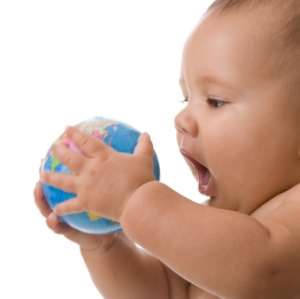Whether you knew twins could be a possibility or it took you by surprise, actually seeing two hearts beats during your first ultrasound can be very emotional (to say the least)! Being pregnant with twins can be exciting, and a bit frightening. With the increased use of reproductive endocrinologists (REI) and amazing medical breakthroughs to treat infertility, twin pregnancies are on the rise. If you’re expecting twins, here are a few things you should know as you embark on your journey!
- Expect more! More doctor’s appointments, more time during each visit and possibly more doctors involved in your care. Two babies means two little lives to monitor, so expect to spend a bit more time in your doctor’s office with each visit. She’ll want to check both heartbeats and take a look at how each baby is developing. As the pregnancy progress, you may find yourself being seen more frequently than your friend who has one baby. And don’t be surprised if you are co-managed with a Maternal-Fetal-Medicine specialist (also known as a High-Risk Obstetrician) to help monitor both you and your babies.
- While most twin pregnancies result in two healthy babies, there is a heightened risk of gestational diabetes, pre-eclampsia, pre-term labor, and pre-term delivery when you are pregnant with multiples. Talk to your doctor about theses risks, and be sure to keep up with your prenatal visits in order to catch any potential problems before they become more complicated.
- You may need a higher dose of folic acid. Check with your doctor to see if she recommends a folic acid supplement or an adjustment in your daily dosage of prenatal vitamins. Folic acid reduces the risk of neural tube defects in your babies, and a higher dose is often recommended in the case of twins.
- You’ll probably gain more weight in a twin pregnancy than you would if you were carrying one baby. Don’t panic! You’ll be carrying the weight of two babies and encouraged by your doctor to gain 5 – 10 pounds more than the average woman carrying one baby. These extra calories and nutrients are sustaining two lives, not including your own!
- C-section delivery can be a more likely outcome in a twin pregnancy. When you’re carrying multiples, you may want to be a bit flexible with your birth plan. The higher incidences of pre-term labor, the possibility of one baby being in the breech position and any other complications that may arise during your pregnancy make your chance of having a C-section slightly higher.
With a degree of knowledge, monitoring, and close communication with your doctor, you can enjoy a healthy and informed twin pregnancy. Making sure you keep tabs on your body and your babies throughout your term is recommended and will put your mind at ease as your near your due date.
Bathtime 101: The Basics of Bathing Your Newborn
Keeping your newborn baby clean is all about moderation. Bathing your baby regularly, but not excessively, and keeping water, bath products, and your own touch as gentle as possible are all key. Read on for the basic information you need to keep your baby clean and his skin healthy.
Your newborn, initially, will not need a bath everyday. Frequent bathing is not necessary, as your baby won’t be sweating, getting muddy, or smearing food on his face, as an older baby or a toddler would! Bathing every three days should be sufficient, especially if you’re quick to clean his diaper area and diligent about wiping spit-up and milk throughout the day. And until your baby’s umbilical cord falls off, a sponge bath is easiest. You can place your baby on a soft towel, and, while always keeping one hand on your baby, gently wipe his face with a moderately warm, wet washcloth, and then move on to his body. Pay special attention to creases and skin folds, under the arms, and behind the ears. Use a clean, wet cloth for his diaper area, focusing on that area last.
Once your baby is ready for a tub, consider the different options available. Many infant tubs are in the form of plastic basins that are placed in the bathtub and allow your baby to lay down while you bathe him. However, many parents are now opting for infant tubs that look a bit like buckets and allow your baby to remain upright while being bathed. These tubs can be soothing for babies who do not like baths, or are more comfortable being held vertically.
Keep safety in mind every time you bathe your baby. Never leave her alone in the tub, and keep a hand on her at all times. Make sure the water is warm, but not too hot, and test it throughout the bath to make sure your faucet’s temperature hasn’t risen or fallen dramatically during the course of your baby’s bath. You only need a couple of inches of water in the bath, and you can begin by rinsing her body with a cup of warm water until she is ready to be wiped gently with a warm, wet cloth and a small amount of gentle soap formulated especially for babies. You can rinse the soap off by pouring more water over her. If her hair seems especially dirty, or if your baby has trouble with cradle cap, you may use a gentle baby shampoo, being careful not to get any of the suds on her face.
After your baby’s bath, be sure to dry her off completely with a towel, as wet skin will make her chilly very quickly. Once she is dry, choose soft, warm clothing. Taking measures to be as gentle as possible and to make bath time soothing and comfortable will teach your baby that bath time can be a positive, fun ritual, and will make daily baths much easier as she grows into a toddler!
Three Ways to Make Your Baby’s World Less Toxic
 Throughout your pregnancy, you’ve been doing everything possible to protect your baby from harm and to enhance their development. From prenatals to abstention from unpasteurized cheese, you’ve had a close eye on everything to which you’ve exposed yourself and your baby. But after she’s born, your baby will need you to keep a watch on everything from toys and bottles to strollers and car seats. Toxins and carcinogens lurk in many popular products. Here’s how to identify them, and what to look out for.
Throughout your pregnancy, you’ve been doing everything possible to protect your baby from harm and to enhance their development. From prenatals to abstention from unpasteurized cheese, you’ve had a close eye on everything to which you’ve exposed yourself and your baby. But after she’s born, your baby will need you to keep a watch on everything from toys and bottles to strollers and car seats. Toxins and carcinogens lurk in many popular products. Here’s how to identify them, and what to look out for.
- Babies love to put things in their mouths. Pacifiers, teething rings, bottles, and plastic toys are all bound to be some of your baby’s favorite items to gnaw on. But some brands manufacture items that contain BPA, PVC, and phthalates. BPA, or bisphenol A, has been shown to put infants and children at moderate risk of neural and behavioral complications, and PVC contains a carcinogen that is linked to lung and prostate cancer. Phthalates have been linked to a disruption in normal reproductive system development in infants and children, and has been classified by the CDC as a possible carcinogen. When buying toys, pacifiers, or teethers for your children, check the label and look for products that are BPA, PVC, and phthalate-free.
- Nursing pillows are likely to be one of the surfaces your infant lies on, drools on, and rubs his face on most frequently in those early months when he isn’t capable of supporting his head well and needs support while nursing. But many nursing pillows are manufactured with toxic, flame-retardant chemicals. Look for nursing pillows that are made with organic materials to make sure your baby isn’t exposed to unnecessary toxins.
- Many car seats and strollers have been found to contain a variety of toxins. Since your child will spend so much time not only in their infancy, but throughout their young lives, hanging out in a stroller or car seat, try to buy a brand that is moving away from using these types of toxins. Many high-end strollers are already manufacturing toxin-free products, and popular brands such as Graco and Britax have stated that they will be studing ways of reducing toxins in their products as well.
There’s no way to entirely shield your baby from toxins. From the everyday products in our homes to the air, we breathe, toxins are rampant. But by keeping the items that will be in closest proximity to your baby toxin-free, you’ll be going a long way in protecting her from dangerous chemicals and materials.
5 Tips for Coping with Sleep Deprivation
 The first few months of your baby’s life are notorious for one thing in particular: robbing you of your usual eight hours of restful, uninterrupted sleep. At first, you’ll be blind-sided by the effects of sleep deprivation, but we have some tips to get you through this trying time!
The first few months of your baby’s life are notorious for one thing in particular: robbing you of your usual eight hours of restful, uninterrupted sleep. At first, you’ll be blind-sided by the effects of sleep deprivation, but we have some tips to get you through this trying time!
- Nap when the baby naps. OK, you’ve heard this one before. But a surprising number of new moms try to use their baby’s naptime to do some laundry, catch up on email, or send thank-you cards for baby gifts. It’s OK to blow off some of these tasks in order to catch an extra 45 minutes of rest. Your body will thank you for it later in the day!
- Rethink caffeine. How does caffeine affect your body? Does it deliver the momentum you need for hours on end? Or does it simply give you a burst of energy, only to let you crash soon afterwards? And if you drink coffee too late in the day, does it affect your sleep, no matter how exhausted you are? Use caffeine wisely. It can be a great asset, but may sabotage you if not consumed with care!
- Post-its are your friend. Your memory is going to be shot after several sleepless nights, so start writing things down. A friend of ours puts post-its in strategic locations all over her house, reminding herself to check the oven before leaving the house, put the wet laundry into the dryer, and walk the dog.
- Hydrate and take your vitamins. We swear, dehydration makes sleep deprivation so much worse! And when you’re entirely focused on your baby’s needs, it’s easy to forget the basics. Drink water. Take your multivitamins. If you can’t give your body sleep, give it everything else it needs.
- Remember that this stage won’t last forever. At 3am, when you’ve woken up for the third time and can’t get your baby to go back to sleep, and you’re not sure if you can continue doing this, remember that you won’t have to. It may take weeks or months, but there is an end to the sleep deficit in your future!
Moms, how do you cope with sleep deprivation? Let us in on your tips for getting through those exhausting days and nights!
Taking him from gummy grins to gap-toothed smiles, teething is an important part of your baby’s development. Your baby’s first set of teeth is called his primary teeth, and they usually start to come in at any time between 3 months to 12 months of age, though most infants begin to teethe at around 5 to 6 months. Certain symptoms will tip you off that the process is beginning, and there are ways for you to soothe his achy gums during this time.
Symptoms of teething:
An increase in fussiness. Your baby may experience some discomfort a few days before her teeth break through, and she may let you know with a bit more crying, whimpering, and waking than usual.
A bit more drooling. You didn’t think it was possible, right? While she’s teething, your baby may actually drool more than usual, resulting in soggy shirts and bibs, and possibly a bit of irritation on her lips, cheeks, and chin.
Occasional nipping and gnawing. Because pressure relieves a bit of teething discomfort, your baby may occasional gum at her bottle, your nipple, or toys and other objects.
Relief of pain and discomfort:
Cold pressure will help ease your baby’s teething pain. Rubbing or applying light pressure to his gums with a cold teething ring or a wet washcloth may be of some relief.
A mild pain reliever such as acetaminophen or ibuprofen, directed for use in infants, can calm your baby’s pain and help him get some rest.
Provide him with firm toys with no sharp angles that he can safely chew on, especially when out in the stroller or in the carseat, when you can’t directly administer to his aching gums.
While uncomfortable for many babies, teething is a natural part of every baby’s development. Don’t panic if your baby has a week or two of disrupted sleep or crankiness, as this will eventually pass. And the result with be an adorable, uneven smile that means your baby is growing up!
Labor and Delivery: 10 Ways Your Partner Can Support You
 As the end of your term nears, you may be thinking about your birth plan and how to prepare for the hospital. But email this article to your support person, whether that is your husband, partner, a family member, or a close friend, because there are ways for your partner to support you that are important to think about in advance.
As the end of your term nears, you may be thinking about your birth plan and how to prepare for the hospital. But email this article to your support person, whether that is your husband, partner, a family member, or a close friend, because there are ways for your partner to support you that are important to think about in advance.
- Attend classes. Childbirth education classes will help your partner to support you through the pain and exhaustion of birth, as well as help him to understand the procedures and protocols that are key to your hospital stay.
- Pack it up. Your partner should prepare his own hospital bag to ensure he has what he needs to spend nights with you, stay entertained while you rest, or take pictures. We’ve put together a handy guide to essentials here: http://pinterest.com/bostonbabybegin/hospital-bag-must-haves.
- Get to know hospital staff. The doctors, nurses, reception staff, and everyone else working on the maternity floor want you to have the best labor and delivery experience possible. The more your partner thanks them, listens to them, and asks them questions, the more he’ll understand their roles and how to get the support you both need.
- Speak up. There may be moments when you have questions or need something from your doctor or the nursing staff, but are not at your most articulate. The more your partner can communicate your needs, the better.
- Crowd control. While your entire family may be on stand-by, waiting for news, you may not want all of them to pile into the labor and delivery room with you. Your partner is the right person to allow entrance only to the people you want in the room, and for only the amount of time you prefer.
- Updates. Your extended family and close friends are all waiting to hear news about your healthy baby once she is born. Whether you want to email a select group of people with the news, or post pictures on Facebook, tell your partner in advance what you’d like him to communicate and to whom.
- Don’t be squeamish. From sweaty skin to needles to blood and other fluids, your partner will be witness to quite a bit in the labor and delivery room. If he is at all squeamish, get him prepared. Ask him to watch birth videos, read about what he’ll see and hear, and if he feels queasy or weak in the knees while you’re giving birth, he needs to be able to get ahold of himself and be strong for you!
- Documentation. Do you want a video of the entire labor process? Or would you rather a few pictures be taken after the baby is born and you’ve had a chance to wipe the sweat from your hairline? Either way, let him know what’s appropriate and what’s not.
- Clean up! After you’ve given birth, you’ll be relocated to a different room for the rest of your stay. Ask your partner to make sure all of your personal items come with you, as you may not have the presence of mind to do a visual sweep of the area.
- Remain calm. Your partner will be experiencing a lot of emotions while in the room with you, ranging from fear and nervousness to elation. While he is entitled to all of these emotions, he may want to practice putting on a brave, calm face for you.
So print this out or email it to your partner. Having a support person who is prepared, calm, and on your side will prove invaluable when the time comes for you to head into the hospital!
Sex During Pregnancy: Your Four Biggest Questions, Answered
 A lot of change can take place in a couple’s marriage during pregnancy. On top of the congratulations, the stroller-buying, and the financial planning, your sex life may be altered a bit. As your body changes and your hormones rise, you may find yourself worrying about how it will affect your romantic relationship with your partner.
A lot of change can take place in a couple’s marriage during pregnancy. On top of the congratulations, the stroller-buying, and the financial planning, your sex life may be altered a bit. As your body changes and your hormones rise, you may find yourself worrying about how it will affect your romantic relationship with your partner.
Is it safe to have sex during pregnancy?
In most cases, yes. Both vaginal and oral sex are generally considered safe during pregnancy. As your baby develops, she is well-protected by your strong uterine muscles and the amniotic fluid that surrounds her. She can’t be harmed by the impact that vaginal sex has on the body. And while you do experience uterine contractions during orgasm, these contractions are entirely different from the kind that precipitate labor.
When is sex unsafe during pregnancy?
In some cases, your doctor may advise you against sex during pregnancy. If you have a history of preterm labor or birth, you may be advised to hold off during your third trimester. If you have a condition called placenta previa, in which the placenta partly or entirely covers your cervical openings, or if your cervix opens prematurely, you may be cautioned to not have intercourse. And if you have unexplained bleeding or are leaking amniotic fluid, your doctor will advise against sex.
How can I get comfortable during sex?
As your belly grows, the positions that worked for you and your partner may no longer be comfortable or enjoyable. You may need to get creative. Some couples find that lying side by side works well, and some women prefer to be on top as their bellies grow.
What if I don’t want to have sex during pregnancy?
Pregnancy hormones have different effects on different women. Some women find that they are more interested in sex during pregnancy, while others lose their interest. And some women feel uncomfortable with their new bodies, and may feel less confident during sex. If, for whatever reason, you don’t feel like having sex while pregnant, don’t despair. Long-term relationships go through different stages, romantically, and just because you feel like holding off for now, you may feel differently once your body and your hormones adjust after having had your baby. (Well, maybe not RIGHT after having a baby. Most women are given the greenlight at six weeks postpartum, but feel free to take all the time you need!)
And we know that many partners feel anxious about having sexual intercourse during pregnancy, or may wonder why you’re feeling hesitant. Communicate with your partner about the facts, and about your feelings.
Feeling the Need to Nest? Nine Ways to Satisfy the Urge!
 As you head into your third trimester, you may start feel a nagging little urge. To make things a bit neater. Prettier. Put things in their place. Finish your to-do list. Prepare. Nesting is a natural tendency during tendence. Here are nine ways to channel your energy!
As you head into your third trimester, you may start feel a nagging little urge. To make things a bit neater. Prettier. Put things in their place. Finish your to-do list. Prepare. Nesting is a natural tendency during tendence. Here are nine ways to channel your energy!
The Practical:
- Install your carseat properly and get your hospital bag in order. These are the two essentials you’ll need when you head to the hospital for the big moment!
- Stock up on diapers and wipes and set up your changing station. You’ll be spending a lot of time here!
- Launder, sort, and fold all of the baby clothes you’ve purchased and received as gifts and hand-me-downs. You’ll be thankful to have them organized later.
The Fun:
- Maybe you have a favorite baby boutique in your neighborhood. Stop by for that little item you’ve been admiring, but haven’t purchased, since it’s not essential. Sometimes that extra something in your nursery or your baby’s wardrobe will unexpectedly make your day.
- Do you have a baby book? Take some time to record your feelings and experiences in the pregnancy section.
- Take pictures of you and your partner during your days as an expectant couple!
And you’ll thank us for these later:
- Make a few large meals like lasagnas, macaroni and cheese, or casseroles, and freeze them. When your family isn’t around to cook, and your takeout budget has dried up, you’ll be glad to have these on hand.
- If it’s in your budget, look into having your home professionally cleaned before the baby arrives. It may be months before you even think about cleaning the shower or tub, dusting end tables, or doing a thorough vacuuming.
- If there is anything you normally do to keep yourself groomed, do it now. Get a haircut that’s easy to take care of, and take care of any other routines. You might have trouble fitting these things into your schedule in those first months of your baby’s life.
Are any of you nesting right now? Any big projects on the horizon, or tasks you can’t wait to tackle? Tell us about it!
The Ins and Outs of Baby Wearing: Is It Right for You?
 The most traditional way to transport your baby, the stroller, certainly has its advantages. When you’re walking long distances, up and down hills, or transporting more than one child, the stroller is a no-brainer. But baby-wearing has been growing in popularity lately, in part because of its hands-free nature, and because of the closeness many parents feel to their babies when carrying them in this way.
The most traditional way to transport your baby, the stroller, certainly has its advantages. When you’re walking long distances, up and down hills, or transporting more than one child, the stroller is a no-brainer. But baby-wearing has been growing in popularity lately, in part because of its hands-free nature, and because of the closeness many parents feel to their babies when carrying them in this way.
If you’ve never considered wearing your baby as a form of transporting her, think about your lifestyle and how this method might meet your needs. Do you take public transportation frequently? Having your little one close to your body and having two hands available can be a huge asset. If you find yourself making multiple stops on foot throughout your day, and getting the stroller around, in, and out of every location is a hassle, then baby-wearing may work for you. And of course, carrying your baby close to you allows you to feel his movements and heartbeat, and will let him feel yours as well. It can be very calming for babies who don’t like a lot of distance from mom and dad!
Choosing the right baby carrier for you may require a bit of trial and error. There are carriers that position your baby on the front of your body, and strap onto your torso. These will feel very sturdy and will not shift very much when your are in motion, which can be a plus. There are front facing, body-facing, and even backpack models, and some come with waterproofing and sunshield options. But if you find this type of carrier to be a bit too heavy or too hot for you or your baby, you may want to choose a sling. Baby slings are often worn around the home, but many parents wear them outside as well. When worn properly, slings are very stable and are a bit more lightweight and breathable than some carriers. But if you’re a worrier and like the more constructed feel of a carrier, the sling may not be for you.
You may want to take your baby to the store and try out different models of baby carriers and slings before choosing the one that will work for you and your baby. And you may find that your partner prefers a different carrier, so make this shopping trip together! Of course, your stroller will likely remain an important component of your baby gear, but moms and dads are loving the option of holding their baby close and keeping their hands free, so it couldn’t hurt to explore whether an item like this might work for your family.
Photography courtesy of Creative Commons.
The Newborn Stage: Five Ways it Gets Easier
 There’s no denying that the newborn stage is intense. Along with the wonderful highs of meeting your baby for the first time, falling asleep with her on your chest, watching her blossom in those first few weeks and months, there are also a lot of challenges. Between sleep deprivation and the constant feeling that you’re not quite sure what you’re doing, you may have moments when you feel a bit at sea. Happily, some of the more challenging aspects of this phase improve with time.
There’s no denying that the newborn stage is intense. Along with the wonderful highs of meeting your baby for the first time, falling asleep with her on your chest, watching her blossom in those first few weeks and months, there are also a lot of challenges. Between sleep deprivation and the constant feeling that you’re not quite sure what you’re doing, you may have moments when you feel a bit at sea. Happily, some of the more challenging aspects of this phase improve with time.
- Sleep. Your sleep will never be as disturbed as during those first few weeks and months. Newborns wake up two or three times each night to be fed, which means that you’re waking up with them. Sleep deprivation can affect your mood, your cognitive abilities, and your overall sense of wellbeing. But with every week that passes, your baby will sleep for longer stretches. When you wake up at 3am to feed your baby in those early days, you can be consoled by the fact that it does, slowly, eventually, get better.
- Feeding. Feeding your baby, whether by breast or bottle, can be a wonderful experience and a great way to bond with your baby. But the frequent feedings that newborns require can be a bit taxing at times. Luckily, your baby will eventually need fewer feedings and may also adjust to a more routine feeding schedule, making your days and nights a little easier!
- Worrying. The first night you bring your baby home, you may feel a bit of panic. You are now responsible for this new life, and every sigh, twitch, or cry may cause you to worry about your baby’s wellbeing. But as the weeks go by, you’ll become accustomed to your baby’s mannerisms, and more confident your own abilities as a parent. While being a parent means that the worrying never totally ends, you won’t find yourself panicking quite as frequently as time goes by.
- Smiling and laughing. In the first month of your baby’s life, you may wonder what is going on in his little head. His facial expressions will change mainly in response to light, sound, and, frankly, gas. But as he enters his second month, you’ll begin to be rewarded with smiles and, eventually, laughter. Those long, sleepless nights can begin to feel much easier to endure when you’re greeted with a big smile during playtime!
- Movement. With age, your baby will become more mobile, and therefore, a little bit more fun! She may wave, kiss, and manipulate more objects as she gets a little more mobile. Being able to really “play” and communicate with your baby can be incredibly rewarding.
Cherish those newborn moments, as there’s nothing like those early weeks. But let it be some consolation that your long, sleepless nights, and constant feedings will yield something even more wonderful: a flourishing, happy, and healthy child!



